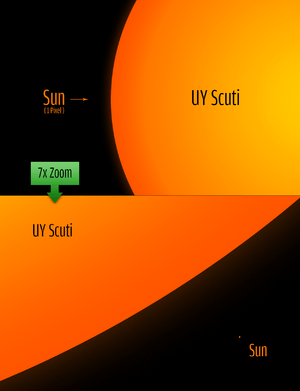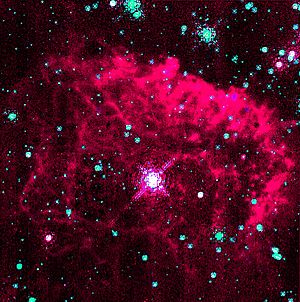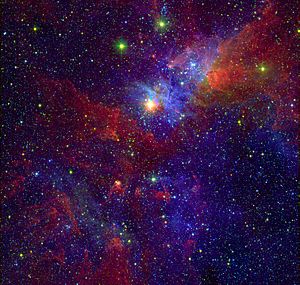Hypergiant facts for kids


A hypergiant is a super-duper big and bright star. These stars are truly enormous! They are much bigger than regular supergiant stars. Hypergiants also lose a lot of their material into space. Scientists are still working on the exact definition of a hypergiant.
Hypergiants are some of the biggest stars we know in the universe. For example, UY Scuti is a hypergiant. It is about 1,700 times wider than our own Sun! Another huge hypergiant is NML Cygni. It is about 1,650 times wider than the Sun.
These giant stars are very rare. They also have a very short life. Our Sun will live for about 10 billion years. But hypergiants only exist for a few million years. This is because they are so big and use up their fuel very quickly.
Types of Hypergiants

There are two special kinds of hypergiants. They are called luminous blue variables (LBV) and yellow hypergiants. Both types are very hard to find. We only know of a few examples in our Milky Way galaxy.
They are rare because stars only stay in these stages for a short time. It's like a quick phase in their lives before they change again.
Why Hypergiants Are Unstable

Hypergiants are incredibly bright. Their brightness is often very close to something called the Eddington limit. This limit is a balance point. It's where the star's strong gravity pulling inward is almost equal to the powerful light pushing outward.
Imagine the light from the star is like a strong wind. If the star gets too bright, this "wind" of light can become strong enough to blow away parts of the star's outer layers. This means a hypergiant cannot shine much brighter for long periods. If it did, it would start throwing off huge amounts of its own material.
One famous example is Eta Carinae. This star is one of the most massive stars ever seen. It is about 130 times heavier than our Sun. It shines four million times brighter than the Sun! Eta Carinae might sometimes go over the Eddington limit.
For instance, between 1840 and 1860, Eta Carinae had massive outbursts. During these outbursts, it lost much more material than stars usually do. This shows how unstable these giant stars can be.
Images for kids
-
Very Large Telescope image of the surroundings of VY Canis Majoris
-
A hypergiant star and its proplyd proto-planetary disk compared to the size of the Solar System
-
Field surrounding the yellow hypergiant star HR 5171
See also
 In Spanish: Hipergigante para niños
In Spanish: Hipergigante para niños




